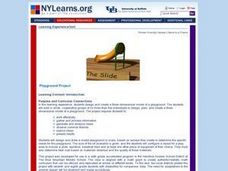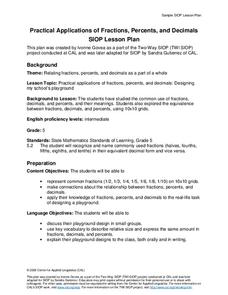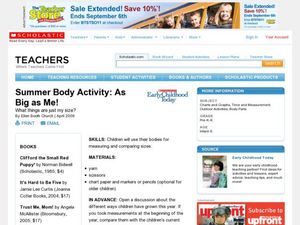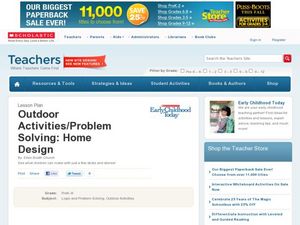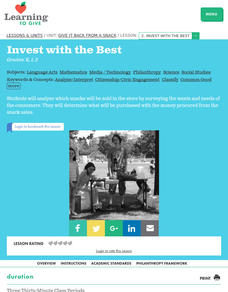Curated OER
Math: Designing a Playground
Sixth graders design and draw a model playground to scale. They configure the layout to include a sandbox, slide, baseball field and other equipment. Their design includes adaptations for students with disabilities. Their designs are...
Curated OER
Activity Plan 2-3: Outdoor Picture Math
Students match images of objects to their real counterpart. In this play-based matching instructional activity, children explore the playground and match real play equipment with what is seen in pictures. Lesson includes a language...
Howard County Schools
Building a Playground
Scholars crave practical application. Let them use the different models of a quadratic function to plan the size and shape of a school playground. They convert between the different forms and maximize area.
Curated OER
Outdoor Activities/Problem Solving: Math Goes to the Playground
Students build their math skills outdoors. In this early childhood math lesson plan, students use comparative language as they chart and graph the items on their playground.
Curated OER
Solids in the Playground
First graders locate and identify solids in the schoolyard. In this geometric solids lesson plan, 1st graders locate two solids on the playground. They work as a group to compare and contrast them according to shape, texture, weight,...
Illustrative Mathematics
Shape Hunt Part 2
Shapes are everywhere in the world around us, from rectangular doors to the circular wheels of a car. The second lesson in this series opens the eyes of young mathematicians to this wonderful world of shapes as they search the classroom,...
Center for Applied Linguistics
Practical Applications of Fractions, Percents, and Decimals
Young architects are prompted to design a playground in assigned groups. Using a 10 x 10 grid. Your fifth graders will apply their knowledge of fractions, percents, and decimals to the real-world task of designing a playground....
Curated OER
Summer Body Activity: As Big as Me!
Students explore things that are their size, literally. In this early childhood lesson plan, students use their bodies for measuring and comparing sizes as they work in pairs to complete the activity.
Curated OER
Problem-Solving Math 2
Young readers view the video "Problem-Soving: Math Episode 2." They discuss the strategies featured in the video. They brainstorm some school-based problems such as, trash on the playground, noise in the hallways, limited handicapped...
Curated OER
Points on a Line
Get your learners up and moving, all while reviewing numbers on the number line! For this activity, learners are grouped in teams outdoors. The teacher will have already created number lines on the ground (with chalk, tape, etc.), and...
Curated OER
"Polly"gon Pockets
Explore polygons with your elementary learners. Divide the class in 12 to configure the polygon puzzle before them. They list the attributes of each type of polygon they see, and if there's time, they jump on the interactive website...
Purdue University
The Represented World: Recreational STEM
How are forces and motion important to a swing set? Scholars explore the concepts of force and motion using swing sets. In preparation for their own STEM design project, individuals take surveys and data from peers, complete labs on...
Curated OER
School Yard Waste
Fourth graders examine the types of garbage that they collect on the playground. They collect the information in a spreadsheet and create a graph that displays the number of types of trash found. They design and monitor a playground...
Curated OER
Parallel and Perpendicular Lines
Fourth graders create a dance with a partner that shows parallel and perpendicular lines. In this lines lesson plan, 4th graders create symmetrical designs and line pairs with their partner.
Curated OER
Problem-Solving: Use Money problem solving 20.9
In this solving consumer math word problems worksheet, students write answers showing the steps to understand, plan, solve, and check their answers. Students write four answers.
Curated OER
Outdoor Activities/Problem Solving: Home Design
Students create with sticks and stones. For this early childhood lesson plan, students use their problem-solving skills to make houses out of items they find outdoors.
Curated OER
Coordinate Grid: Mapping Archeological Sites
Fourth graders discover how to apply the Cartesian coordinate system by figuring out the length and width of their school playground. They determine that pacing is an important tool for the initial mapping of a site. Students conduct a...
Curated OER
Migrating Math
Pupils practice estimating distance traveled while walking. Also can be used to introduce backpacking/hiking or as a daily warm-up. Measure the blacktop/cafeteria/playground, then determine how many times around make a mile.
Curated OER
Create A Map!
Students examine two- and three-dimensional shapes, and discuss map skills and attributes. They plan and create their own school campus maps using pre-cut building site shapes.
Curated OER
How Wet Did It Get?
Students measure the rainfall/snowfall on the playground on a rainy/snowy day with a rain/snow gauge. They draw a bar graph representing the amount of water that fell and observe a satellite image of the clouds and local weather system...
Curated OER
Mobile-ize
Second graders, using a minimum of four space figures, create a mobile. They use a "Draw" program to first plan out their figure.
Curated OER
Give It Back From a Snack Lesson 2: Invest With the Best
Students survey schoolmate as to what type of snacks they would prefer to purchase. They graph the results and apply them to planning a classroom snack sale while examining what wants, needs, and consumers are.
Curated OER
Outdoor Activities: Solve It-Outdoors
Students practice problem solving skills. In this early childhood education lesson, students foster the ability to use creative and critical thinking to turn obstacles into bridges to greater learning as they complete various activities...
Curated OER
100 Day Chick Hunt
Students investigate how to count to the number 100 with the connection to using chicks as objects. They use cutouts of chicks and place them into the counting chart and recognize the different numerals while counting at the same time.
